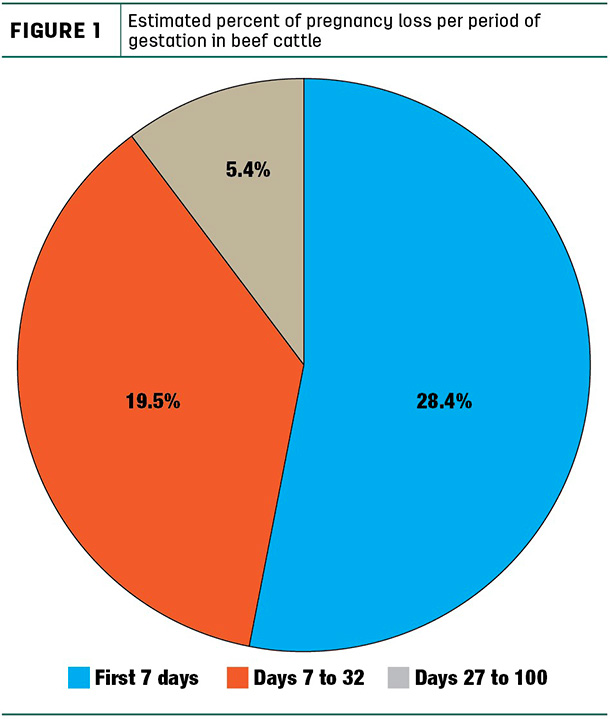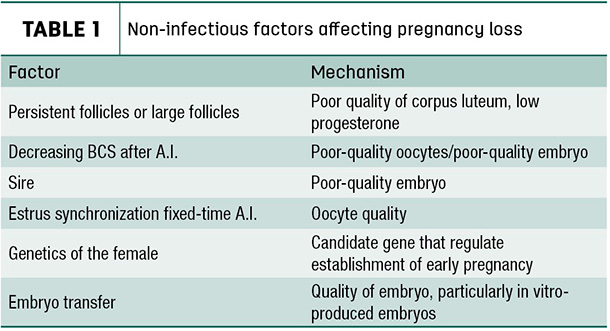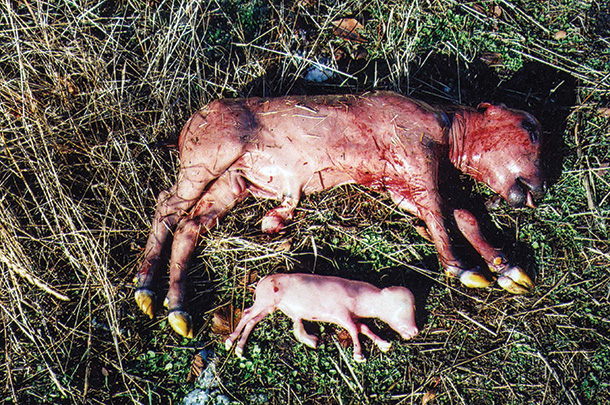Sometimes accidents of gestation or other factors terminate pregnancy.Immediately after conception, when the tiny embryo is traveling down the oviduct into the uterus, it is fairly safe from harmful influences, but after it reaches the uterus a few days later, it becomes more vulnerable.
Dr. Ram Kasimanickam, professor of theriogenology at Washington State University, says there are three categories of pregnancy loss: early embryonic death, abortion and stillbirth. The conceptus is an embryo during the first 42 days while organs and body systems are forming. Then it becomes a fetus. Loss before 42 days is called early embryonic death. After that, it’s called an abortion. “Abortion is expulsion of a dead fetus or a living one incapable of maintaining life outside the uterus. Stillbirth is a full-term calf dead at birth,” he says.
Pregnancy losses in early gestation are unnoticed; the embryo is resorbed in the uterus or too small to be seen if expelled – coming out with fluid from the uterus. The cow comes back into heat, and you may think she didn’t settle.
Early loss due to poor egg or sperm quality
Dr. Ahmed Tibary, also a professor of theriogenology at Washington State University, says many embryos that are lost die before the eighth day – before or as they come down into the uterus. “These embryos are already degenerating. There is also substantial loss before day 14. These losses don’t affect the cow’s return to heat in her next cycle,” says Tibary.
“Often, the egg was not good to start with. Another factor can be alterations in the fertilizing semen. Research is looking at possible defects in semen and effect of genetics on quality of the embryo. In some situations, the bull and cow combination [genetically] may lead to increased early embryonic loss,” Tibary says.
The cycle just previous to breeding affects quality of the egg. Cows that have not been cycling normally before they are put with a bull – and bred on their first heat after calving – may have less chance for normal pregnancy.
Many causes for loss
Dr. Dietrich Volkmann, professor of theriogenology at the University of Missouri, says the earlier you do pregnancy exams, the more likely there will be losses after the cows were examined. Some cows that were pregnant at 40 days won’t have a calf. “If you do the pregnancy exam later, as is customary on many farms at weaning time, those cows are in midgestation. Pregnancy losses – for whatever reason – are less likely to happen after 100 days than before,” Volkmann explains.

Many things can terminate pregnancy. Some of the non-infectious causes include genetic abnormalities, malnutrition, stress or poisons. Some molds and fungi can cause problems. “Sometimes the toxins produced by fungi [mycotoxins] cause more harm than the fungus itself,” Volkmann says.
“We have no direct evidence that fescue toxicosis [caused by mycotoxins produced by a fungus that grows in the grass plant] causes abortion, but many farmers and veterinarians feel it can,” says Volkmann. Fescue toxicity also hinders ability of cattle to thermoregulate, and they suffer more heat stress – which creates problems during breeding season.
“Some mycotoxins are estrogenic and, if an animal receives too much estrogen, this will interfere with ability to conceive a pregnancy,” says Volkmann. “Certain clovers in pasture can affect pregnancy rate because they interfere with early pregnancy. I don’t know to what extent some of these mycotoxins might interfere with later loss.”

Many toxicants may affect the fetus – lupine, hemlock, locoweed, pine needles, ergot alkaloids, certain molds, nitrates, etc. Pine needle abortion occurs in late pregnancy and can occur any time between three days to two to three weeks after exposure. “Greatest risk is when cows consume pine needles for three days or more. A high level of this toxicant constricts blood vessels in the placenta, and blood circulation to the fetus is reduced,” Kasimanickam says. This reduces oxygen and nutrient supply to the fetus, and it dies or is born prematurely because the toxicant also increases uterine contractions that leads to expulsion of the fetus. If cows stay under pine trees for shelter during cold, windy weather, they may eat a lot of pine needles.
There are also genetic defects that may result in pregnancy loss. Some defects kill the conceptus early on, while others create abnormalities that make it impossible for the fetus to survive outside the uterus.
When a cow conceives twins, one or both may be lost. “If a cow carries a twin in each horn of the uterus, the loss is less compared to when twins are in the same horn,” says Kasimanickam. “At birth there may be only one calf, but if it’s a freemartin, you know there was a twin bull calf present at some point,” he explains.
Stress
 The difference between a 4-month-old fetus and a 6-month-old fetus . Photo by Heather Smith Thomas.
The difference between a 4-month-old fetus and a 6-month-old fetus . Photo by Heather Smith Thomas.
Losses from heat stress can occur in early gestation, but heat and humidity can also have long-term effect on quality of eggs, according to Tibary. “Even after temperatures go back to normal, the cow still has eggs in her ovaries that are poor-quality and won’t produce good embryos.” It might take several cycles before she can carry a pregnancy.
Some studies have shown that cows with shade had better pregnancy rates than cows without shade. “Another factor, in addition to climate conditions, is fermentation in the rumen – which generates additional heat,” explains Kasimanickam.
Stress from hot weather causes hormonal imbalances that affect embryonic survival. “Brahman or Brangus handle heat much better than Angus. But in general, heat stress can cause damage in early pregnancy,” he says. This can be a disadvantage when calving in late spring/early summer and breeding in July or August, when heat stress may affect breeding ability of bulls and cause pregnancy loss in cows.
“When I was in Virginia, we noticed a difference in pregnancy rates between fall-calving herds compared to spring-calving herds, in the same location. Fall-calving cows are bred in December, and heat stress is not a problem,” Kasimanickam says.
Any type of stress – whether nutritional, environmental or a combination – can cause release of cortisol in the cow’s body and have a detrimental effect on pregnancy. Any high level of stress creates risk. Stress from hasty gathering and moving cattle out of a burning area [range fire, forest fire] or stress from predators [harassment by wolves] can spike cortisol level. A study in Oregon showed lower pregnancy rates in range cattle in the presence of wolves.
Transport stress can be a factor in pregnancy loss, especially in the first month of gestation. “Shipping cattle immediately [one to four days] after A.I. is best, while the embryo is still in the oviduct and less likely to be subjected to [and affected by] uterine changes,” says Kasimanickam. It’s also safer after day 42, when pregnancy is well established and the placenta fully attached; the fetus is less susceptible to changes resulting from stress.
“Shipping seven weeks after A.I. is usually considered safe, but pregnancy loss due to shipping has been reported up to 60 days after insemination. Try to reduce stress when animals are transported. Never overcrowd trucks or trailers, and handle cattle as gently and calmly as possible,” Kasimanickam says.
Nutrition and mineral status can also be a factor in pregnancy loss. Nutritional stress (lack of feed, too-high or too-low protein levels, lack of essential nutrients and minerals) can cause early embryonic death. Later in gestation, if cows don’t have enough to eat, they may lose a fetus from starvation. Pregnancy rates this year were lower in some regions that were severely affected by drought.








